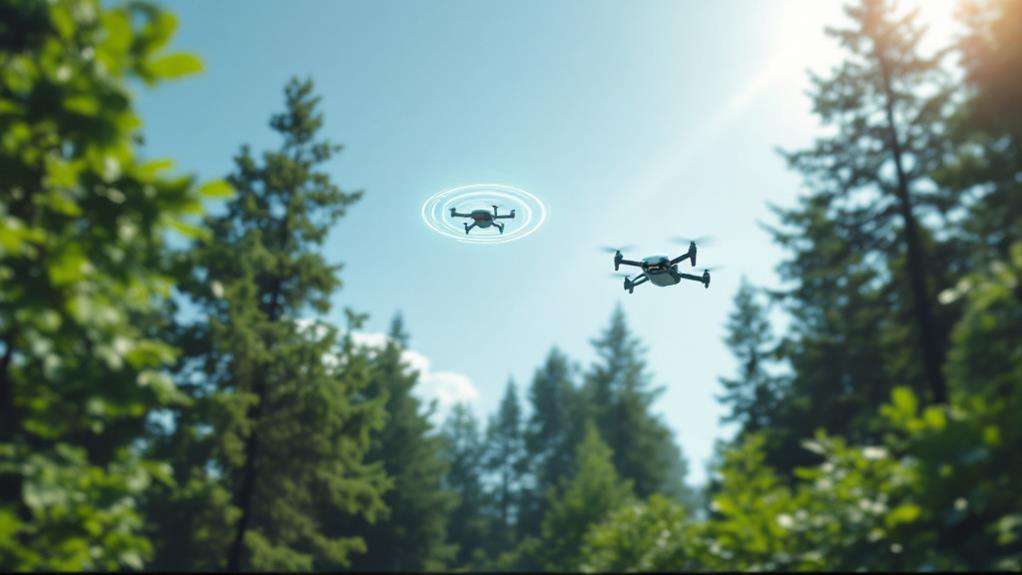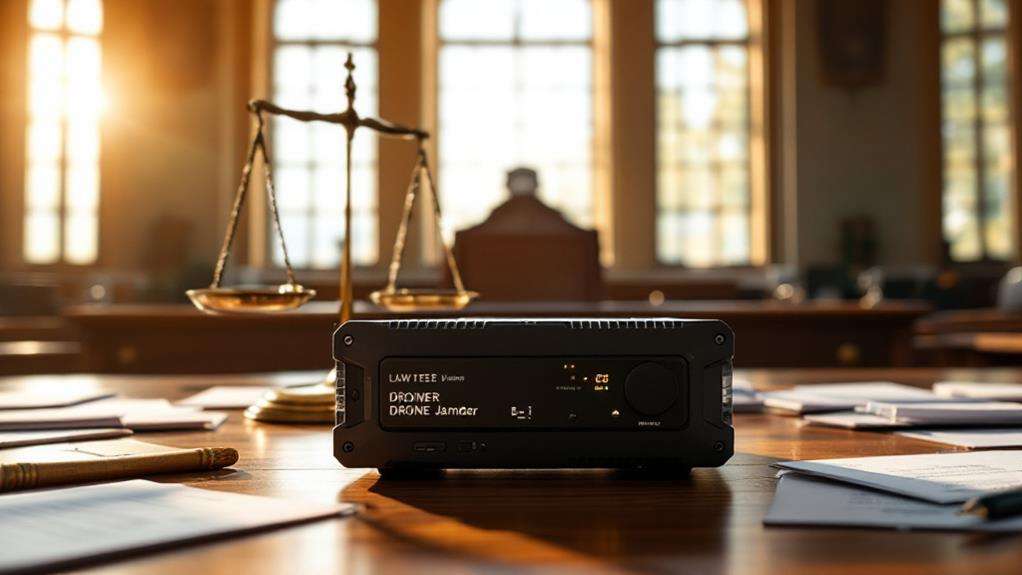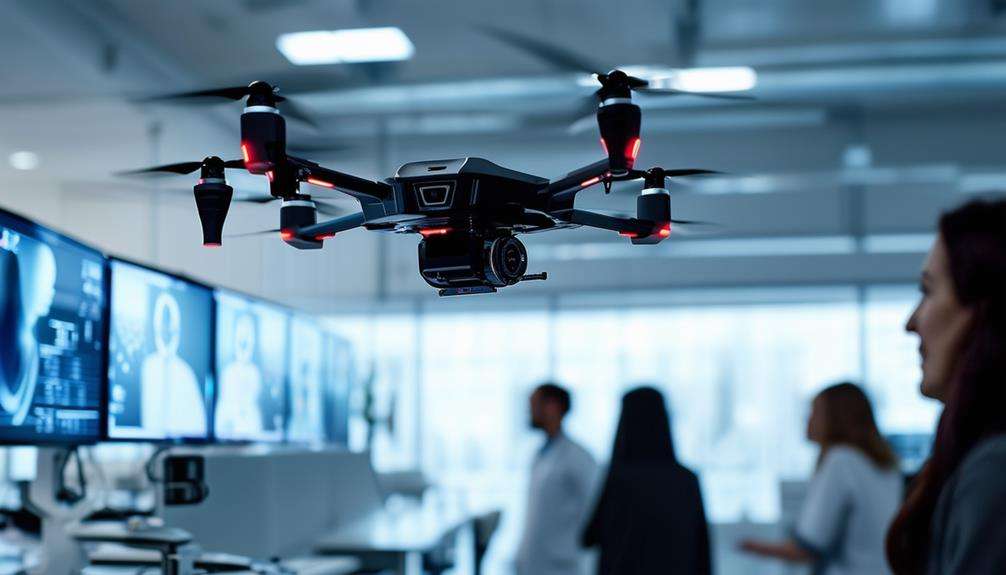What Is a Drone Jammer?

A drone jammer is a device that you use to block communication between a drone and its operator. It emits electromagnetic signals that disrupt crucial control frequencies, typically between 2.4 GHz and 5.8 GHz. These devices come in portable, stationary, and tactical varieties and are used in settings like military operations, events, and prisons. By jamming signals, they're often capable of causing a drone to land or return home. While they provide security benefits, be aware of legal restrictions, which vary by region. Curious to know how different types match specific needs and conditions? There's more to uncover about these devices.
Key Takeaways
- Drone jammers disrupt radio signals between drones and operators by emitting electromagnetic noise.
- They primarily target communication frequencies ranging from 2.4 GHz to 5.8 GHz.
- Jammers are used to neutralize unauthorized drone activity in sensitive areas.
- Types of jammers include portable, stationary, tactical, and multi-band variants.
- Legal use of drone jammers varies significantly across different countries.
Understanding Drone Jammers
Delving into the world of drone jammers, you'll discover that these devices are essential tools for disrupting the radio signals between drones and their operators. These jammers work by emitting electromagnetic noise to interfere with communication links, compelling drones to land or return, making them crucial for maintaining security, especially in environments where unauthorized drone activity poses a threat. By targeting the radio frequencies commonly used in unmanned systems, typically ranging from 2.4 GHz to 5.8 GHz, signal jammers can effectively ground or redirect drones. This disruption of communication is crucial for maintaining security, especially in environments where unauthorized drone activity poses a threat.
When you use a drone jammer, you're engaging in a proactive approach to protect sensitive areas. The range of these jammers can vary significantly, with some models capable of disrupting signals from as far as 1000 meters away. This means they can adapt to different operational contexts, whether you're safeguarding a small perimeter or a larger zone.
As the demand for these devices grows, driven by security concerns and the need to mitigate potential threats from unmanned systems, understanding how they operate becomes increasingly important. Drone jammers play a vital role in ensuring that drones remain under control, preventing unauthorized surveillance and ensuring safety in areas where drone activity must be managed carefully.
Types of Drone Jammers
When exploring the types of drone jammers, you'll find a variety of options tailored to different needs and environments. Portable jammers are compact and user-friendly, making them perfect for personal use. They can effectively disrupt drone signals within a range of up to 1000 meters. If you need a more robust solution, stationary jammers are permanently installed devices that cover larger areas, often used in critical infrastructures like airports and military bases. These signal blockers are essential for maintaining security in sensitive locations.
For military and law enforcement agencies, tactical jammers are the go-to choice. These rugged devices feature advanced targeting capabilities, providing precise disruption of drone operations. Multi-band jammers are another versatile option, as they can target multiple frequencies simultaneously. This makes them effective against various drone models that operate on different control frequencies.
Here's a quick comparison of the types of drone jammers:
| Type | Key Feature |
|---|---|
| Portable Jammers | Compact, user-friendly, range up to 1000m |
| Stationary Jammers | Permanent installation, covers large areas |
| Tactical Jammers | Rugged, precise targeting capabilities |
Understanding these options helps you choose the best drone jammer for your specific needs.
How Drone Jammers Operate

Drone jammers work by emitting strong radio frequency signals that interfere with the communication frequencies drones use, effectively blocking the control signals sent between the drone and its operator. By targeting common control frequencies such as 2.4 GHz and 5.8 GHz, these devices disrupt the communication systems essential for drone operation. When the jamming effect kicks in, the drone loses its connection, causing it to either return to its home position or land immediately, depending on the drone's fail-safe protocols. It's important to note that clear regulations and guidelines are essential to ensure ethical drone usage and to protect individual privacy rights. You'll find that drone jammers come in various forms. Portable handheld devices offer flexibility and mobility, making them suitable for quick deployments. Stationary installations provide consistent coverage for areas needing continuous protection. Tactical systems, often used by military or law enforcement, offer more robust jamming capabilities. Regardless of their form, all these systems share the common goal of disrupting drone signals.
The effective range of these jammers varies, typically between 200 to 1000 meters. This range allows you to create a protective perimeter around sensitive areas. By understanding how drone jammers operate, you can effectively counter unauthorized drone activities and maintain control over your airspace.
Applications of Drone Jammers
Understanding how drone jammers operate is just the beginning; their applications are where their true potential is realized. In military operations, drone jammers play a critical role by neutralizing unauthorized drone threats. They protect personnel and sensitive installations from aerial surveillance and potential attacks. The jamming signal effectively disrupts communication between rogue UAVs and their operators, ensuring a secure environment.
High-profile events like the Super Bowl also benefit from drone jammers. They're employed to prevent unauthorized drones from entering restricted airspace, safeguarding attendees and maintaining order. Similarly, in prisons, drone jammers are vital for enhancing security. They counteract the smuggling of contraband by disrupting the UAVs used for such illegal activities.
Airports face significant drone threats, and drone jammers help manage these risks by keeping airspace clear of unauthorized drones. This ensures flight operations run smoothly and passenger safety is upheld. Law enforcement agencies incorporate drone jammers to tackle issues associated with rogue UAVs in public spaces. Whether managing crowds during events or maintaining control during emergencies, these jammers are key to addressing unauthorized drone usage. By deploying a jamming signal, they provide a safe and controlled environment.
Legal Considerations

Navigating the legal landscape of drone jammers can be quite complex, as laws vary significantly from one country to another. In the U.S., the Federal Communications Commission (FCC) strictly regulates drone jammers. Unauthorized jamming can result in fines up to $112,000 under the Communications Act of 1934. National security concerns often influence these regulations, as uncontrolled jamming could interfere with essential communications.
Here's a quick overview of legal considerations by country:
| Country | Legal Status | Exceptions |
|---|---|---|
| United States | Illegal without authorization | Federal agencies for national security |
| United Kingdom | Legal to own, illegal to use | Prison use since 2012 |
| Australia | Illegal without PMTS C license | None |
| Canada & EU | Generally illegal | Federal law enforcement agencies only |
In the United Kingdom, while owning a jammer is legal, using it is prohibited except in specific cases like prisons. Australia requires a PMTS C telecommunications license for legal operation, while many jurisdictions, including Canada and the European Union, outlaw jammers altogether. Unauthorized jamming in countries like Italy can lead to severe penalties, including up to eight years in prison. Always check local laws before considering the use of drone jammers to avoid serious legal repercussions.
Key Features to Consider
When choosing a drone jammer, understanding its key features is crucial for ensuring it meets your specific needs. The effective range of a drone jammer is a primary consideration, as it dictates how large an area you can cover. Most jammers offer ranges from 200 to 1000 meters, which is heavily influenced by the power output. A higher power output, typically between 35W and 150W, results in better performance, allowing the jammer to disrupt drone signals over greater distances.
Frequency coverage is another essential feature. Many drones use common frequencies like 2.4 GHz and 5.8 GHz for communication, so it's vital your jammer can target these. Opt for devices that cover these frequencies to maximize effectiveness.
Portability is also important, especially if you need to use the jammer in different locations. Handheld and backpack models provide the flexibility to deploy your jammer in various environments, making them suitable for tactical operations.
Lastly, consider multi-band capability. Advanced jammers can disrupt multiple frequency ranges simultaneously, increasing their effectiveness against a wider array of drone models. By weighing these features, you can select a drone jammer tailored to your requirements.
Popular Drone Jammers

If you're exploring the market for effective drone countermeasures, several popular jammers stand out for their unique capabilities. First up, the DRONEKILLER is renowned for its high power and long-range effectiveness, making it ideal for military and security applications. It's perfect for those needing a robust defense against unauthorized drones. Then there's DroneShield, designed for tactical applications with military-grade specifications, offering versatile deployment in various environments.
Another standout is the DroneDefender V2. This device uses directed energy technology for RF jamming, disabling drones without causing physical harm—ideal for non-destructive neutralization. MyDefence Pitbull is a lightweight, wearable drone jammer, perfect for personal security in military contexts and tactical scenarios. It allows you to stay mobile while still providing effective jamming capabilities.
Finally, the Dedrone DroneTracker integrates detection and tracking capabilities with its jamming systems, offering a comprehensive defense against unauthorized drone activities. This integration makes it a great choice for those looking to consolidate their drone defense strategies.
Here's a quick overview:
| Drone Jammer | Key Feature |
|---|---|
| DRONEKILLER | High power, long-range effectiveness |
| DroneShield | Tactical, military-grade specifications |
| DroneDefender V2 | Non-destructive, RF jamming |
| MyDefence Pitbull | Wearable, portable |
| Dedrone DroneTracker | Detection and jamming integration |
Each of these solutions provides unique advantages, so choose one that best fits your needs and context.
Challenges in Drone Jamming
As you explore drone jamming, you'll encounter several challenges that can complicate effective deployment. First, the directional nature of drone control signals requires precise targeting, especially in dynamic urban environments where radio communications can be congested. This complexity demands that your jamming devices be highly accurate, increasing the difficulty of successful deployment.
Moreover, drones are evolving rapidly, with many incorporating advanced anti-jamming features. This evolution forces jamming devices to continuously adapt, presenting a significant challenge in keeping up with cutting-edge drone technology. The high costs associated with these sophisticated jamming systems might deter you from investing in such technologies, thus limiting your operational capabilities.
Resource constraints also play a critical role. Personnel shortages and budget limitations can hinder the widespread implementation and maintenance of drone jamming technologies, making it challenging to ensure security operations are adequately equipped.
Countermeasures Against Jamming

Even though drone jamming poses significant challenges, there are effective countermeasures that can be employed to maintain control over your drone operations. One powerful approach is utilizing frequency hopping or spread spectrum technology. This allows your drone to rapidly switch frequencies, making it difficult for jammers to disrupt communication.
Advanced jamming detection systems can be a game-changer. They alert you to jamming signals, so you can quickly adjust and regain control. Furthermore, some drones come equipped with GPS spoofing countermeasures, which help them ignore false signals and navigate accurately.
To emphasize the benefits of these countermeasures, consider the following:
| Countermeasure | Benefit |
|---|---|
| Frequency Hopping | Avoids interference from jammers |
| Jamming Detection Systems | Alerts and enables quick response |
| GPS Spoofing Countermeasures | Recognizes and ignores false signals |
| Mesh Networking | Enables coordinated drone responses |
Mesh networking is another effective strategy. It allows drones to communicate and coordinate, sharing information about interference. Dynamic frequency management systems add another layer of resilience by continuously monitoring signal quality and automatically adjusting transmission frequencies. These countermeasures can help you ensure effective communication and control, even in the presence of jamming attempts.
Future Developments in Technology
Looking ahead, future developments in drone jamming technology promise to significantly enhance operational capabilities. You'll see an exciting shift towards selective jamming devices that can target specific frequencies used by a wide range of drone models. This means you can improve operational efficiency by disrupting only unauthorized drones while leaving legitimate communications untouched. Innovative technologies are set to play a crucial role, with advanced algorithms allowing these devices to distinguish between authorized and unauthorized signals more effectively.
Artificial intelligence is another game-changer on the horizon. By integrating AI, drone jammers will become more adaptable and responsive to evolving drone technologies and tactics. Imagine a system that learns and anticipates threats, offering a robust defense against unauthorized drones. This adaptability will be key in maintaining a secure environment while complying with regulatory standards.
Non-invasive jamming solutions are also in development, aiming to balance security needs with the regulations, which could make them more acceptable for civilian use. As these technologies advance, you can expect improvements in portability and ease of use, enabling rapid deployment in tactical scenarios. Whether for military or law enforcement, these future developments promise a more secure and controlled airspace.




